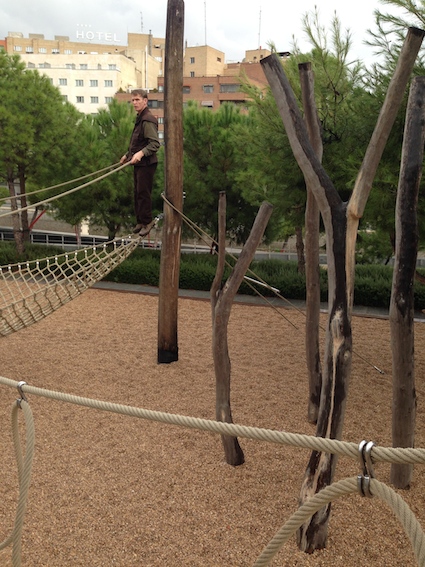
What makes a good play park? This is a question I always ask myself and to answer I have to go back to my childhood. I appreciate I had an extraordinary childhood with huge amounts of freedom and play parks featured heavily.

Unlike many people, spending hours making mud pies was not my scene. I liked play parks. I loved swings, witches’ hats, plank swings (zigzags), roundabouts, cool climbing structures and slides. The rush of air whizzing past my cheeks was a feeling I sought. Structures which involved being able to swing… and then jump off were a lot of fun. Speed mattered.

To be able to experience height was also important. I liked the sensation of being high up and the dizziness of looking down. I craved the physical challenge of gymnastics and pushing my body to try things I saw my peers achieve before me. Being able to climb up a knot-free rope was deeply satisfying. Going to the highest point I felt safe in a tree gave me shivers of delight.
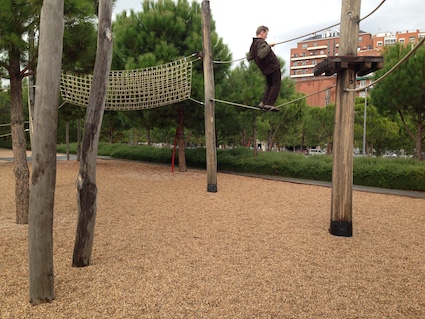
As I got older, the need for speed and height didn’t subside. Sadly play parks became a bit too small even though my quest for a perfect swing and slide never stopped.
When I was in Madrid, I came across this wonderful play park designed by Richter-Spielgerate. It’s in the Salon de Pinos in the Rio Madrid Park, on the opposite bank to the Real Palacio. There is a smaller version on the opposite bank further downstream.

What immediately struck me was the level of challenge. Here was a play park which would test my nerve. The levels of risk were obvious – lose your balance and you will fall off. If you can’t hang on, you will fall off. If you want the satisfaction of travelling from one end of the playground to the other without touching the ground, you need to be very physically able.
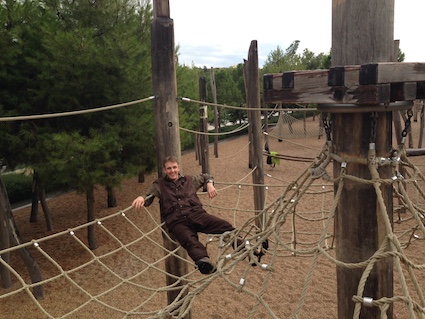
Saying this, the playground has been designed for children aged 6+years. There were numerous access points throughout the play park and one of the slides didn’t require you to access it via a knotted rope – although the best slides did. Also on this wet day those slides were too slippery to climb up! I liked how the features constantly invited me to challenge myself which I feel is a subtle matter that many playgrounds miss.
I also loved the social element of this play park. The big net was clearly a place to hang out and recover from physical exertions. But also the linear rope features were designed to hold large numbers of children and could be accessed from both sides.
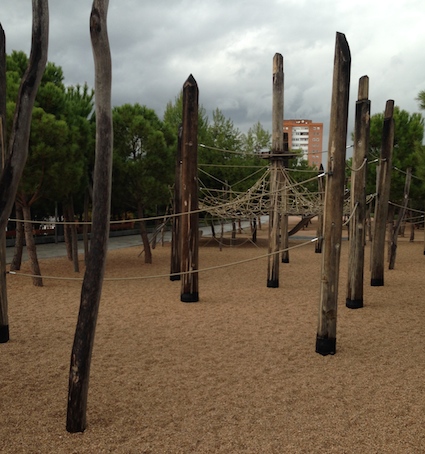
I liked how the playground complemented its surroundings. The pine trees added to the feeling of height experienced and I suspect as they mature will add to the “tree top” experience. In addition to the climbing ropes and slides were smooth bare, pine trees inserted upright into the ground. Some of these wobbled. But I can image for some children invited further challenge to climb up. The surroundings thus added to the play value of this park. It felt harmonious.
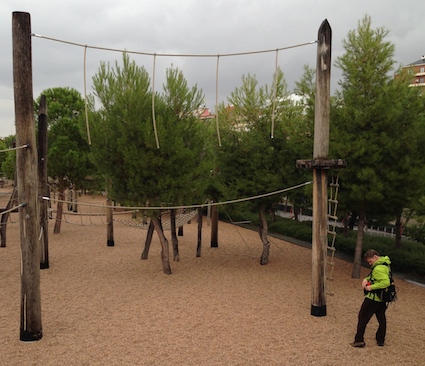
It was well-maintained with the wood cracks being infilled with resin. Also the posts have protection at the foot so that less wear and tear happens. There was no doubt that this play park was being well used – you could see the wear and tear on the ropes.
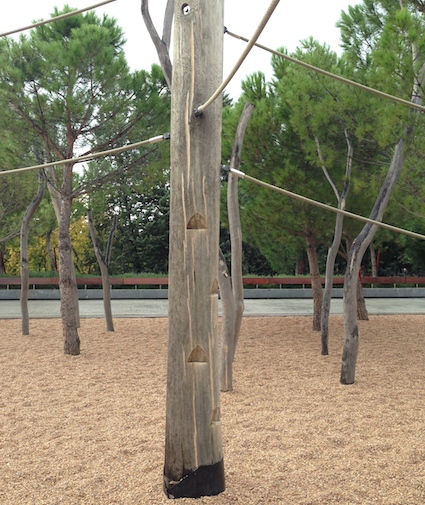
In the photo above you can also see step-up notches have been carved into the wood. However these did not work as hand holds so a certain level of skill was required – I ended up doing a combo of hugging and shoogling – a bit like a tree climber might.

After some digging around the Richter-Spielgerate website, it turns out this is a very good example of their “climbing forest” modular systems. The wood used is oak and I rather liked their claim that this is not a high ropes course! Thank goodness for that!
So, if you are visiting Madrid, then this play park is a less-well advertised place for children to visit. The Rio Madrid Park is one of the city’s hidden gems.
This blog post first appeared in October 2015.






























What a great looking park and some real challenges in there. I’m sure these would not pass UK safety regulations but it looks like there is a pretty soft landing and it looks a good way for kids to learn their abilities as we did as children. It looks so in keeping with it’s surroundings too. Well done Spain. Thank you for sharing with me on Country Kids
Hi Fiona
Interestingly, this playspace is designed using a modular system which is available within the UK although I’ve not seen any examples yet. Timberplay is the UK arm of Richter-Spielgerate. The UK safety regulations are based upon the EU playground safety regulations and Richter-Spielgerate use consultants that also sit on the safety advisory panels in various countries. I think what this playground shows to demonstrate is what is possible to have and how to make a playground as safe as necessary.